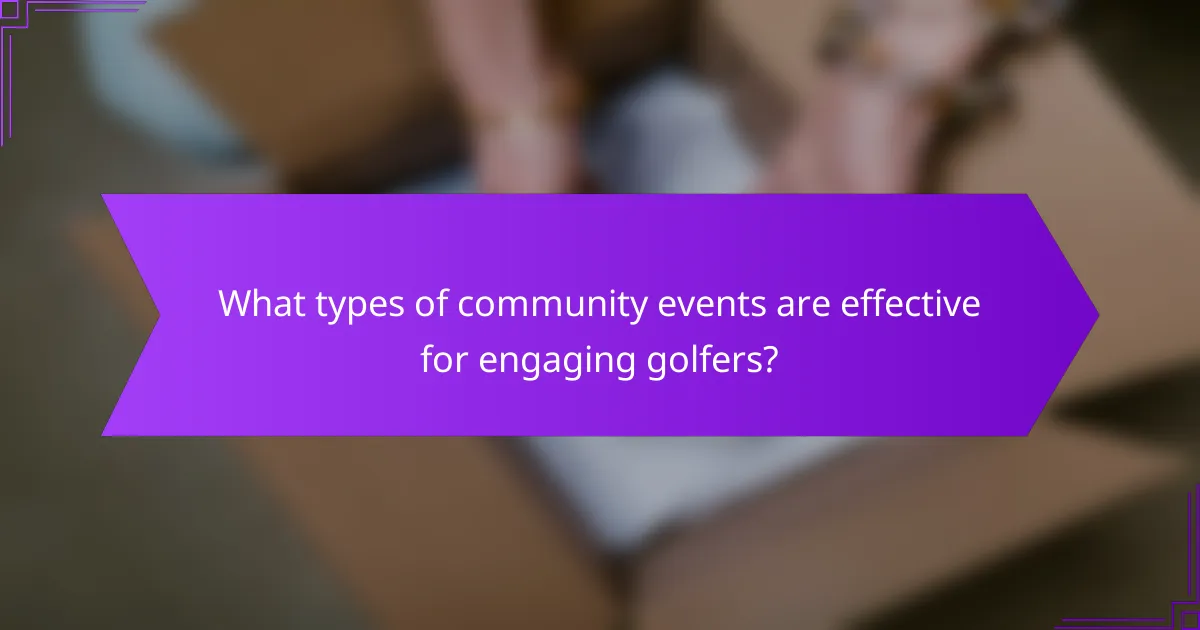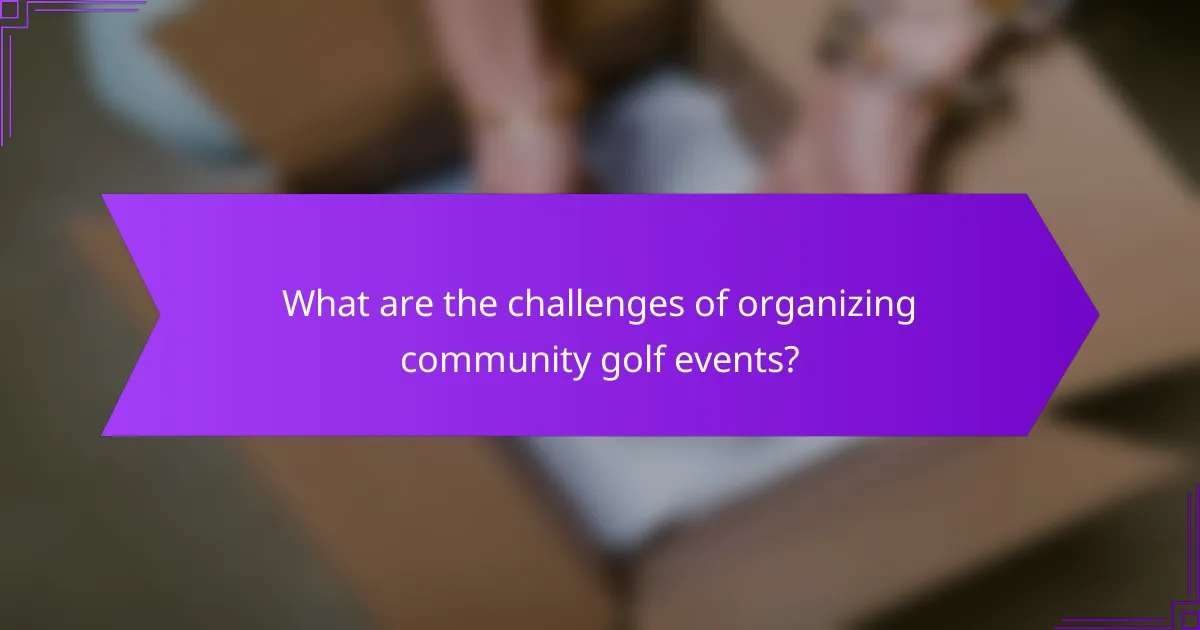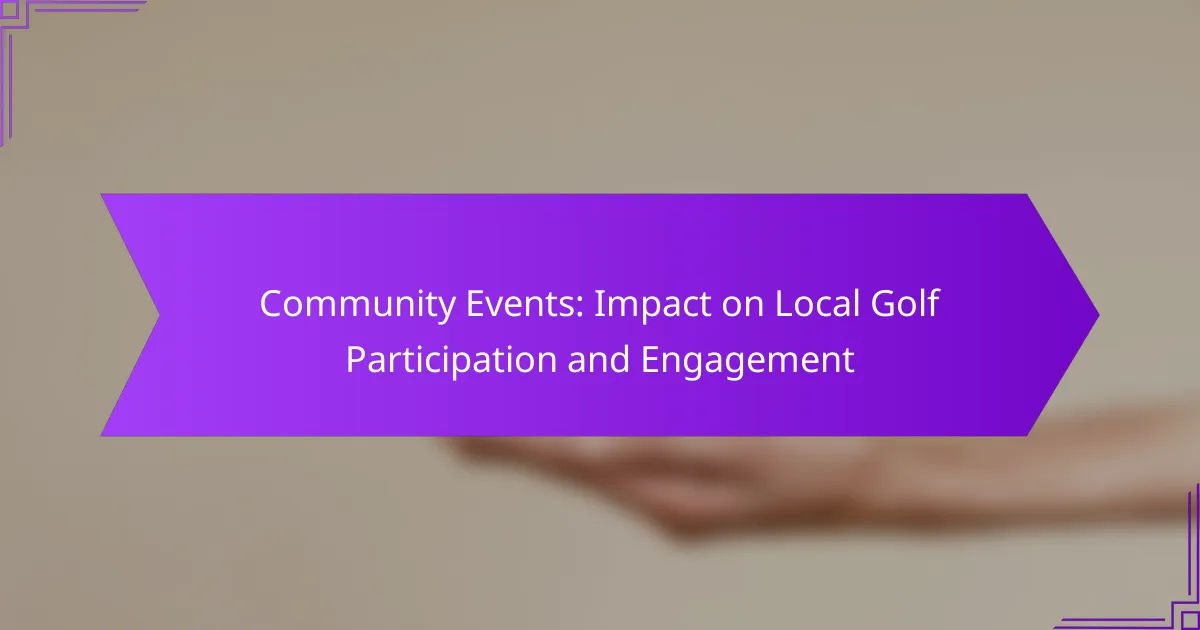Community events play a crucial role in boosting golf participation in Los Angeles by offering engaging experiences that attract newcomers and cultivate a sense of community. Through tournaments, charity events, and clinics, these activities not only promote skill development but also encourage social interaction among golf enthusiasts, ultimately enhancing the overall golfing experience.

How do community events boost golf participation in Los Angeles?
Community events significantly enhance golf participation in Los Angeles by creating engaging experiences that attract new players and foster a sense of belonging. These events often highlight local golf courses and provide opportunities for social interaction, skill development, and networking among enthusiasts.
Increased visibility of local golf courses
Community events raise awareness of local golf courses by showcasing their facilities and amenities. When courses host tournaments, charity events, or open days, they draw attention from both seasoned players and newcomers, increasing foot traffic and potential memberships.
For instance, a charity tournament can bring in hundreds of participants who may not have previously considered playing at that course. This exposure can lead to increased bookings and a stronger community presence.
Enhanced social interaction among players
Community events create a platform for players to connect and build relationships, which is vital for fostering a vibrant golf culture. Participants often meet others with similar interests, leading to new friendships and regular playing partners.
Social interactions during these events can also encourage players to join clubs or leagues, further enhancing their commitment to the sport. Networking opportunities can lead to informal tournaments and events, keeping the community engaged.
Opportunities for skill development
Many community events include clinics, workshops, and friendly competitions that cater to various skill levels, providing valuable learning experiences. Beginners can receive instruction from professionals, while more experienced players can refine their techniques through practice sessions.
For example, a local golf course might host a series of workshops focusing on different aspects of the game, such as putting, driving, and course management. These opportunities not only improve individual skills but also promote a culture of continuous learning within the community.

What types of community events are effective for engaging golfers?
Effective community events for engaging golfers include tournaments, charity events, and clinics. These activities foster participation, build camaraderie, and enhance the overall golfing experience.
Golf tournaments and competitions
Golf tournaments and competitions are popular ways to engage local golfers. They provide a structured environment for players of all skill levels to compete, socialize, and improve their game. Organizing events like club championships or friendly matches can attract participants and spectators alike.
When planning a tournament, consider factors such as format (stroke play or match play), entry fees, and prizes. Ensure that the event is well-promoted through local channels, including social media and community boards, to maximize participation.
Charity events and fundraisers
Charity events and fundraisers are effective for engaging golfers while supporting local causes. These events often combine golf with a philanthropic mission, encouraging golfers to participate for a greater purpose. Examples include charity scrambles or auctions held at golf courses.
To successfully organize a charity event, partner with local organizations and promote the cause. Set clear fundraising goals and provide incentives for participation, such as raffle prizes or recognition for top fundraisers. This approach not only boosts engagement but also strengthens community ties.
Golf clinics and workshops
Golf clinics and workshops are excellent for engaging golfers looking to improve their skills. These events can cover various aspects of the game, from swing techniques to putting strategies, and cater to different skill levels. Offering clinics led by experienced instructors can attract both new and seasoned players.
When organizing a clinic, consider the duration, group size, and specific topics to be covered. Promote these events through local golf shops and community centers to reach a wider audience. Providing a welcoming atmosphere encourages participation and fosters a love for the game.

How can local golf clubs organize successful community events?
Local golf clubs can organize successful community events by focusing on collaboration, effective promotion, and inclusivity. Engaging the community through well-planned activities can enhance participation and foster a love for the sport.
Collaborate with local businesses
Partnering with local businesses can provide mutual benefits and enhance event visibility. For example, golf clubs can seek sponsorships from nearby restaurants or shops, which can offer discounts or prizes in exchange for promotion at the event.
Consider creating packages that include golf rounds and local dining experiences, encouraging attendees to explore the community. This not only boosts participation but also strengthens ties between the golf club and local enterprises.
Utilize social media for promotion
Social media platforms are essential for promoting community events effectively. Golf clubs should create engaging posts that highlight event details, share photos from past events, and encourage user-generated content to build excitement.
Utilizing targeted ads can help reach specific demographics, such as families or young adults. Regular updates and reminders can keep the event top-of-mind, increasing the likelihood of attendance.
Incorporate family-friendly activities
Including family-friendly activities can significantly boost community engagement at golf events. Options like mini-golf, putting contests, or kids’ clinics can attract families and make the event enjoyable for all ages.
Consider scheduling activities that allow parents to participate while their children are entertained, such as family tournaments or scavenger hunts. This approach not only increases attendance but also fosters a welcoming atmosphere for newcomers to the sport.

What metrics measure the impact of community events on golf engagement?
Metrics that gauge the impact of community events on golf engagement include participation rates, membership growth in local clubs, and feedback from participants. These indicators help assess how effectively events attract new players and enhance overall interest in the sport.
Participation rates in events
Participation rates indicate how many individuals attend community golf events, reflecting the event’s appeal and accessibility. A successful event typically sees participation rates ranging from the low tens to hundreds, depending on the event’s scale and promotion.
To maximize participation, organizers should consider factors such as event timing, location, and marketing efforts. Engaging local schools and businesses can also boost attendance by fostering a sense of community involvement.
Membership growth in local clubs
Membership growth in local golf clubs serves as a crucial metric for evaluating the long-term impact of community events. An increase in membership often correlates with successful events that introduce newcomers to the sport and encourage them to join local clubs.
Clubs should track membership changes following community events to identify trends. For instance, a club might see a membership increase of 10-20% in the months following a well-attended tournament or open day.
Feedback from participants
Feedback from participants provides qualitative insights into their experiences at community events. Surveys and informal discussions can reveal what attendees enjoyed and what could be improved, guiding future event planning.
Organizers should aim to gather feedback immediately after events to capture fresh impressions. This information can help refine event formats, enhance engagement strategies, and ultimately foster a more vibrant local golf community.

What are the challenges of organizing community golf events?
Organizing community golf events involves several challenges that can impact participation and engagement. Key issues include budget constraints, weather-related problems, and the need for volunteer recruitment.
Budget constraints
Budget constraints are a significant challenge when planning community golf events. Costs can include venue rental, equipment, marketing, and refreshments, which can quickly add up. Organizers should aim to create a detailed budget that outlines all potential expenses and seeks sponsorships or partnerships to alleviate financial pressure.
Consider utilizing local businesses for sponsorship opportunities, which can provide funding or in-kind donations. This not only helps with costs but also fosters community involvement and support.
Weather-related issues
Weather-related issues can greatly affect the success of community golf events. Rain, extreme heat, or cold can deter participants and disrupt schedules. Organizers should have contingency plans in place, such as alternative dates or indoor activities, to ensure the event can proceed smoothly despite adverse weather conditions.
It’s advisable to monitor weather forecasts leading up to the event and communicate any changes to participants promptly. Offering flexible registration options can also help accommodate those who may be hesitant due to weather concerns.
Volunteer recruitment
Recruiting volunteers is essential for the smooth execution of community golf events, yet it can be challenging. Volunteers are needed for various roles, including registration, scoring, and event setup. To attract volunteers, organizers should clearly communicate the benefits of participation, such as community engagement and potential networking opportunities.
Utilizing local schools, clubs, and online platforms can help reach a wider audience for volunteer recruitment. Providing incentives, such as free meals or golf vouchers, can also motivate individuals to contribute their time and effort.



